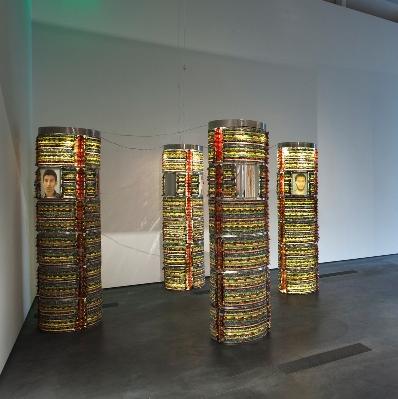On view through September 5, Gifts of the Sultan: The Arts of Giving at the Islamic Courts explores Islamic art through the universal tradition of gift giving. The exhibition features more than 200 works of art from three different continents and spanning the eighth through nineteenth centuries. The exhibition also features the work of three contemporary artists, all with roots in the Islamic world—Sadegh Tirafkan, Ahmed Mater, and Shahzia Sikander—commissioned to interpret the art of gift-giving in Islam. Exclusively on Unframed this week, arts writer and founder of Art Middle East Nazy Nazhand interviews each of these artists about their contributions to the exhibition.

Sadegh Tirafkan, Always in Our Thoughts, 2011, courtesy of the artist and Assar Gallery, Tehran
Part I: Sadegh Tirafkan
Deported from Iraq to Iran at the age of six and a member of the youth militia in the Iran-Iraq war as a teenager, Sadegh Tirafkan experienced loss at an early age. In this remarkable piece, he remembers those lost to him by referencing the hijla, an Iranian tradition of erecting temporary shrines to commemorate the dead. Tirafkan characterizes it as a gift from the living to the deceased. The commemorative structure is suggested here by, among other things, the use of colorful strips of cloth, which allude to bits of fabric tied by visitors to the hijla in remembrance of the loved one.
How does your work relate to the Islamic artistic tradition represented in “Gifts of the Sultan?” How has traditional art influenced your practice?
For me, Islamic art is too broad a label. I’m more influenced by Iranian traditions and history, and the Iranian interpretation of Islamic artistic traditions. But more specifically, with the idea of gift-giving, I wanted to approach it from a spiritual point of view, the idea of people donating something without wanting anything in return. Having no expectations. To be able to live in this world is a gift.
With Hijla, I wanted to present a gift from the living to the deceased in their honor, but to also celebrate life. The word actually means marriage, and traditionally it’s an image of a deceased man, but I wanted to break the taboos and use pictures of living people and also women and include mirrors, so that the viewer can share in the celebration.
What are your thoughts on museum exhibitions like Gifts of the Sultan that juxtapose historical and contemporary artworks?
It should continue to be done this way and I hope more museums do it. Contemporary art gives new perspective to historical works and vice versa, transferring between past influences and present references.

Sadegh Tirafkan, Always in Our Thoughts, 2011, courtesy of the artist and Assar Gallery, Tehran
Where are you currently based? One of the major themes in Gifts of the Sultan is that of cross-cultural interaction and exchange; what are your thoughts on this theme and how does the geographical location of where you work influence your perspective?
I’m Iranian and my art is influenced by Iranian history and culture. But I never want to be categorized by a singular place or category. Names like Orientalism, I don’t understand. My work is about roots and identity. As artists, we should do our job first and not worry about the clichés.
So much has been changed with globalization and the amount of information available to us. Now when you go to galleries in cosmopolitan cities, you see art from all over the world, not just Western art. People want to see something different and to learn about these cultures and the idea of Western and Eastern cultures inspiring each other. I’m based in Tehran and come to North America once a year and travel to Europe and rest of the Middle East throughout the year. For me the constant travel allows for a broader perspective and to absorb the similarities and differences in people and cultures.
Describe your creative process; what are you currently inspired by? What are you currently working on?
I started working as an artist in Iran about twenty years ago and I had my first New York exhibit about ten years ago. In the years since, I’ve worked both inside and outside Iran and I want to continue to do that. I have a desire to be part of the world.
My work has always been organized in three parts; self-portraits, masculinity in Iran, and how my society, my culture and people around me relate to their culture and their heritage. I try to address this step by step—first myself, then my gender, and then people in general. Because if you want to talk about other people, you have to know yourself. I’m not satisfied with just photography any more. I want to explore these themes through a new concept and continue to experiment in multimedia.
Nazy Nazhand is the founder of Art Middle East, a series of programs and cultural events during Armory Arts Week in New York City and Art Platfom – Los Angeles. She’s a contributing writer covering art from the Middle East. She has written for Artnet, Modern Painters, Artinfo, Whitewall, and T Magazine. Follow her: http://blogs.artinfo.com/vanguardism/ and http://twitter.com/#!/NazyNazhand. Additional reporting by Kimia Shahi.



